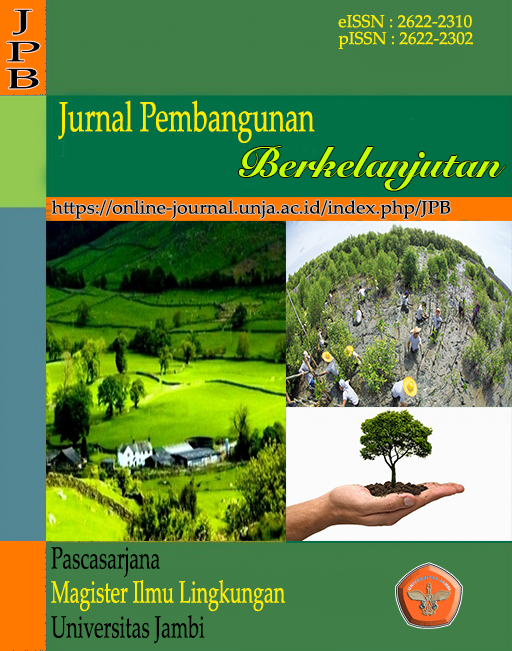Analisis Kualitas Air Sungai Batanghari Berkelanjutan di Kota Jambi
DOI:
https://doi.org/10.22437/jpb.v1i2.5415Abstract
This study was conducted to find the distribution pattern of the Batanghari River water pollution, to find out the status of water quality in terms of the value of the Batanghari River Pollution Index (IP), and to analyze the Batanghari River water management strategy which is sustainable. Determining the distribution patterns of the contamination by analyzing the test results of Batanghari River water quality parameters was conducted by the Environment Agency Jambi. The determination of the status of the water quality is done by using the calculation method Pollution Index (IP) and comparing it to the water quality standard for class I as a source of raw drinking water of Governmental Regulation No 82/2001. The formulation of the strategy of sustainable water management Batanghari River used the SWOT analysis. Batanghari River water flowing from upstream to downstream has decreased quality, as indicated from the parameters of pH, BOD, COD, TSS, Cu, PO4 which exceed the quality standard which has been established. The quality status of Batanghari River water quality is in medium polluted category. So it can be concluded that the water quality of Batanghari River is not suitable for the designation of class 1 as a source of raw drinking water. Thus, it is necessary to implement a strategy for sustainable water quality management of Batanghari River so that the river water can be useful according to its allocation. The sustainable Batanghari River water management strategy that can be carried out is by making Batanghari River as a water tourism area, implementing of the policy on pollution control, increasing knowledge and community participation in the waste management, improving supervision and guidance of water waste disposal, making communal and home industry wastewater treatment and determining the pollution load capacity.
Downloads

Downloads
Published
Versions
- 2018-08-16 (1)
- 2018-08-16 (1)
How to Cite
Issue
Section
License
1. Authors retain copyright and grant the journal right of first publication with the work simultaneously licensed under a Creative Commons Attribution 4.0 International License that allows others to share the work with an acknowledgement of the work's authorship and initial publication in this journal.
2. Authors are able to enter into separate, additional contractual arrangements for the non-exclusive distribution of the journal's published version of the work (e.g., post it to an institutional repository or publish it in a book), with an acknowledgement of its initial publication in this journal.
3. Authors are permitted and encouraged to post their work online (e.g., in institutional repositories or on their website) prior to and during the submission process, as it can lead to productive exchanges, as well as earlier and greater citation of published work (The Effect of Open Access)










